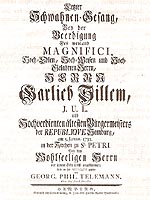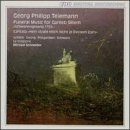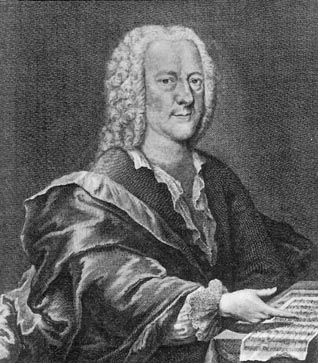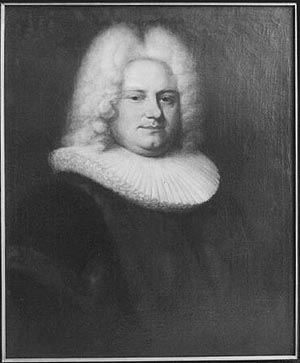Start - Welcome
- History
- Publications - Family Stories - Family News - Family Tree - Weblinks - Sitemap - Members Only
|
| Swan Song 1733 | ||||||||||
| Funeral music for mayor Garlieb Sillem, composed by Georg Philipp Telemann (1681-1767) | ||||||||||
|
||||||||||
 click to enlarge |
Garlieb Sillem, Garlev Sylm in local Low German, was born on the 15th of July in 1676 in Hamburg. After finishing secondary education at Johanneum Grammar School (Gelehrtenschule des Johanneums) he studied law in Frankfurt on the Oder and Halle on Saale. He then opened a law practice in Hamburg. By order of Emperor Charles VI who resided in Vienna, a committee was installed that worked on a new constitution for the city as the community had been derailed for decades due to political turmoil. Garlieb was appointed as one of four Syndici in charge of the process, and was summoned to engage in writing the content of the new constitution. He also became head of the Sanitation Committee. Its main job was to devise measures to prevent the plague from invading the city that was on its way toward the city. A short time after, he was elected as a council member and then as one of the four mayors. The highpoint in his career was his appointment as Executive Mayor, putting him in a position equivalent to that of a sovereign duke or earl. In the Hanseatisches Magazin of 1801 Garlieb Sillem's merits for the fate of the city are described like this: „Kraftvoll
und rastlos thätig für Menschenwohl und Vaterland in trüben Zeiten von Bürgerzwist,
fremder Übermacht und Pest, der hauptsächlich er, als Gründer und Chef der
damaligen temporellen Sanitäts-Deputation Damm und Riegel setzte; späterhin in
ruhigen Zeiten fester und glücklicher Leiter der geläuterten Verfassung“.
He was not to live a long life. He died aged 56. A contemporary reported: „In
der Nacht des 26. Dezember 1732 verstarb Se. Magnifizenz, der Hoch-Edle, Fest-
und Hochgelahrte Herr, Herr Garlieb Sillem, J.U.L. (Juris Utriusque
Licentiatus), ältester und p. t.
präsidierender hochverdienter Bürgermeister. Am 5. Januar 1733 wurde er mit
einem hochansehnlichen und sehr zahlreichen Leichen-Conduct, unter Begleitung
von 420 Paar der vornehmsten Kaufleute und Bürger, ohne der Anzahl von
Gelehrten, Priester und Trauerleute, bei einer ausnehmenden Trauermusik in der
hiesigen St. Petri-Kirche zur Erden bestattet.“
As a Swan Song Garlieb had written the funeral hymn that was to be performed at his funeral himself. The famous composer and musical director Georg Philipp Telemann composed the music. As it was custom that professors of Johanneum Grammar School delivered a deferential speech when a high-ranking personality had passed away Garlieb had decreed in advance: „Dem
Herrn Verfasser des Programms will ich auf die Seele gebunden haben, sich aller Schmeicheleien und Lobeserhebungen
darinnen zu enthalten. Es sind dieselben nichts nütze und nur bei meinem Leben sehr ärgerlich
jederzeit gewesen. Sollte ich etwas Gutes in der Welt ausgerichtet haben, wohin
ich mich wenigstens unter göttlichem Beistand bestrebet, so habe ich je dennoch
nichts gethan, als was ich schuldig gewesen und werde Gott und Menschen nichts
desto weniger ein unnützer Knecht verbleiben“.
|
|||||||||
| |
||||||||||
| |
||||||||||
| CD-Aufnahme | Georg Philipp Telemann: Funeral Music for Garlieb Sillem La Stagione Orchestra Frankfurt |
|||||||||
 |
It is to the credit of Dr.
Jürgen Sillem that Telemann specialist Pofessor Michael Schneider
(at the Music Academy of Frankfurt a. M.) agreed to stage a performance
of the Funeral Music (including a CD recording). The CD with the
recording by the La Stagione Orchestra of Frankfurt is available at Amazon (s. here).
Also at Amazon, there is a review by John Middleton (Auckland, New Zealand) (Source): Music To Die For (March 25, 2006) Long
ago the mayor of Hamburg was one Garlieb Sillem. Hardly a household
name today (though of course, I can't speak for the Hamburgers
themselves, as I live a world away in New Zealand), but at the time a
most famous and honoured gentleman.
Mr. Sillem died at the end of 1732, prompting Telemann to write his memorable funeral music - "Schwanengesang 1733" (Swansong). Interestingly the text he set was penned my none other than Mr. Sillem himself; thus the title. Telemann's tribute to the late mayor was very much admired at the time, and was repeated later on in public concerts. During his long life Telemann managed to outlive a further eight Hamburg mayors, composing similar works for them all. Throughout the work in question Telemann employs the unusual effect of muted trumpets, giving a unique quality. A stately and moving Sinfonia sets the scene wonderfully, and the following chorales, recits and arias hold the attention with their variety and quality. The impressive bass (Gotthold Schwarz) gets the lion's share of solos, but all the soloists have their moments of glory and are first rate. They are each matched up with one other singer for the choruses which creates a pure and clear sound. The cantata on the same disc is equally rewarding. Top marks too to Michael Schneider and his Frankfurt orchestra. |
|||||||||
 |
 |

